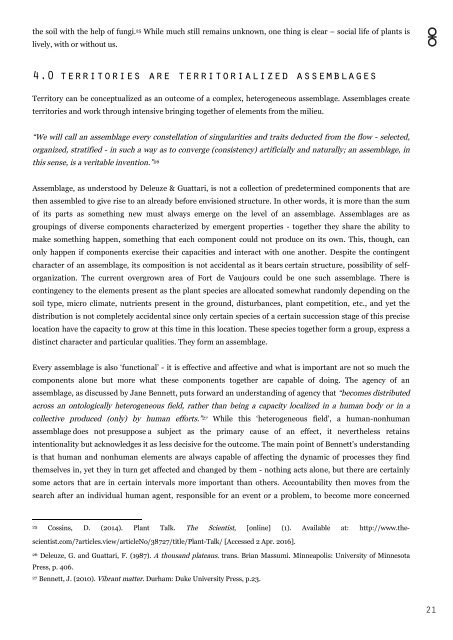Unfamiliar Territory_Research
You also want an ePaper? Increase the reach of your titles
YUMPU automatically turns print PDFs into web optimized ePapers that Google loves.
the soil with the help of fungi. 25 While much still remains unknown, one thing is clear – social life of plants is<br />
lively, with or without us.<br />
⚮<br />
4.0 territories are territorialized assemblages<br />
<strong>Territory</strong> can be conceptualized as an outcome of a complex, heterogeneous assemblage. Assemblages create<br />
territories and work through intensive bringing together of elements from the milieu.<br />
“We will call an assemblage every constellation of singularities and traits deducted from the flow - selected,<br />
organized, stratified - in such a way as to converge (consistency) artificially and naturally; an assemblage, in<br />
this sense, is a veritable invention.” 26<br />
Assemblage, as understood by Deleuze & Guattari, is not a collection of predetermined components that are<br />
then assembled to give rise to an already before envisioned structure. In other words, it is more than the sum<br />
of its parts as something new must always emerge on the level of an assemblage. Assemblages are as<br />
groupings of diverse components characterized by emergent properties - together they share the ability to<br />
make something happen, something that each component could not produce on its own. This, though, can<br />
only happen if components exercise their capacities and interact with one another. Despite the contingent<br />
character of an assemblage, its composition is not accidental as it bears certain structure, possibility of selforganization.<br />
The current overgrown area of Fort de Vaujours could be one such assemblage. There is<br />
contingency to the elements present as the plant species are allocated somewhat randomly depending on the<br />
soil type, micro climate, nutrients present in the ground, disturbances, plant competition, etc., and yet the<br />
distribution is not completely accidental since only certain species of a certain succession stage of this precise<br />
location have the capacity to grow at this time in this location. These species together form a group, express a<br />
distinct character and particular qualities. They form an assemblage.<br />
Every assemblage is also ‘functional’ - it is effective and affective and what is important are not so much the<br />
components alone but more what these components together are capable of doing. The agency of an<br />
assemblage, as discussed by Jane Bennett, puts forward an understanding of agency that “becomes distributed<br />
across an ontologically heterogeneous field, rather than being a capacity localized in a human body or in a<br />
collective produced (only) by human efforts.” 27 While this ‘heterogeneous field’, a human-nonhuman<br />
assemblage does not presuppose a subject as the primary cause of an effect, it nevertheless retains<br />
intentionality but acknowledges it as less decisive for the outcome. The main point of Bennett's understanding<br />
is that human and nonhuman elements are always capable of affecting the dynamic of processes they find<br />
themselves in, yet they in turn get affected and changed by them - nothing acts alone, but there are certainly<br />
some actors that are in certain intervals more important than others. Accountability then moves from the<br />
search after an individual human agent, responsible for an event or a problem, to become more concerned<br />
25<br />
Cossins, D. (2014). Plant Talk. The Scientist, [online] (1). Available at: http://www.thescientist.com/?articles.view/articleNo/38727/title/Plant-Talk/<br />
[Accessed 2 Apr. 2016].<br />
26<br />
Deleuze, G. and Guattari, F. (1987). A thousand plateaus. trans. Brian Massumi. Minneapolis: University of Minnesota<br />
Press, p. 406.<br />
27<br />
Bennett, J. (2010). Vibrant matter. Durham: Duke University Press, p.23.<br />
21


